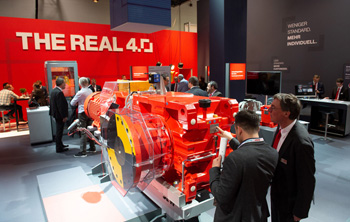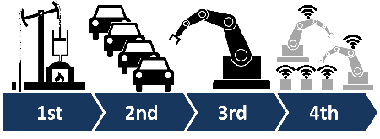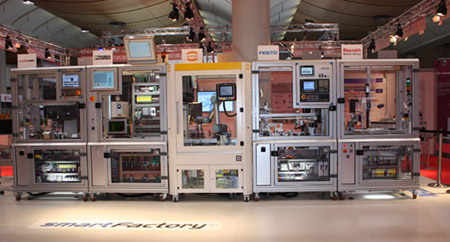10th anniversary Industry 4.0
Big party this year for fans of automation and digitization, because Industry 4.0 - the concept that outlines a future vision for the factory of the future - is celebrating its tenth anniversary. High time, then, to look back at a fascinating story about economic ambition, an unprecedented hype in industrial sectors and the almost inevitable phase of disillusionment that followed.

“The Real 4.0” was a remarkable slogan at one of the exhibitor boots at the Hannover Messe in 2018. In the years before, Industry 4.0 had been everywhere. A product had an Ethernet connector? Then it was “Industry 4.0 ready”. An online configurator was suddenly an app. The design drawing a digital twin.
Slogans such as “The Real 4.0” made it clear in 2018 that people in the industry were gradually fed up with the advice and perspectives that were often miles away from the reality on the production floor. Many new solutions simply went too far, making them too drastic or unnecessarily complex. Others were solutions to problems that did not even arise. Or for which sufficient other solutions were already available.
People wanted to return to a pragmatic approach, based on old, trusted principles such as reliability, predictability and efficiency. After all, factories were running at full speed and the owners made substantial profits. Why risk that for a hip, yet uncertain vision of the future?
Industrial revolution
Seven years earlier - in 2011 - the context was completely different. At the time, the world had just ended the 2008 financial crisis and there was a lot of uncertainty because the early economic recovery depended largely on government intervention. Part of that uncertainty was that governments themselves had had a great responsibility in the emergence of the crisis, and did not want to be completely clear about it. In addition, the industry was constantly feeling the hot breath of the Asian tiger, which seemed unmanageable and seemed to catch up with us in terms of wage costs and gradually also in terms of productivity.
In Germany, the development of “HighTech Strategy 2020” had already started a few years earlier - a program with which the country wanted to secure and strengthen its strong reputation as an industrial power. In that program, the federal government ultimately selected ten projects that received financial support to develop new, innovative solutions. One such project - announced in 2011 - was Industry 4.0.

To emphasize the project's enormous ambitions, the term 4.0 was explained as referring to the fourth industrial revolution. The first revolution was the introduction of the steam engine at the end of the eighteenth century. The second revolution was the emergence of mass production, with Ford's Model T assembly line as a breakthrough moment. The third industrial revolution was the era of modern automation, ushered in by the introduction of the PLC in the late 1960's.
Cyber-Physical Systems
What would characterize the fourth industrial revolution - according to the working group in the HighTech Strategy 2020 program - was the rise of Cyber-Physical Systems and the Internet of Things. With the increasing popularity of the term Industry 4.0 and the involvement of more and more players, the concept has since become much broader and therefore also watered down, but the initial concept was indeed quite revolutionary.
The idea was that in the future all products would become Cyber-Physical Systems, which meant that they would be intelligent thanks to embedded systems and that they would be able to communicate with the outside world. For the factory of the future, this would create the possibility of no longer centrally controlling production, as was common since the third industrial revolution, but that the products themselves would be central to controlling production.
Although that comparison was never made, the original idea was somewhat similar to the Polca production system, but applied on a large scale. If products themselves indicated what to do with them, a highly flexible production system would be created organically, which by definition would be able to produce individualized products with the same efficiency and cost-effectiveness as large-scale series production.
Modular production line

In 2013, visitors to the Hannover Messe got to see the SmartFactory demo plant for the first time - a modular production line that applied the revolutionary basic idea of Industry 4.0. The line made flashlights that could be personalized by engraving a text or logo. By placing a smart tag in each housing at the start of the line, each product became a Cyber-Physical System. Based on the data in the tag, the product further down the line was led to an engraving machine or not, where the tag itself also indicated what had to be engraved on the product.
In addition, a cell for manual assembly was also shown, in which it was also the product itself that controlled the production. A tag in the product contained a list of all production steps and the components and tools that were required. The user interface in the cell went through those steps and visualized them for the operator.
The idea was that the necessary tags would be created at the start of each production order, so that the products would already be created in virtual form. Those tags would then drive the logistics and machines to bring each virtual product to life. A tag could also include priorities or a deadline that would allow the product to request urgent treatment at the factory if needed - again somewhat similar to what the colored flags do in a Polca production system.
On the barricades
The term Industry 4.0 quickly turned out to be a bull's eye and sparked an industry hype that was unprecedented. To implement the ideas of the SmartFactory, all machines and systems in a factory would have to communicate with each other. They would have to use artificial intelligence for which they could find computing power and data in the cloud. Instead of their individual tags in the demo plant, the products themselves would soon switch to fully-fledged digital twins that would be available throughout the entire supply chain and over their entire lifecycle thanks to the cloud. Mobile robots and drones would enable the products to complete their individualized trajectories in the flexible factory of the future. And flexible production - that meant asking for 3D printers, collaborative robots and augmented reality tools.
In short, it was not long before no supplier could come up with an excuse for not fighting the barricades for the new industrial revolution. And they were in turn supported by an army of IT and telecom companies that in that revolution found a new market for a whole range of new cloud services, app development tools and cybersecurity solutions. These IT companies were increasingly present at the Hannover Messe and by 2016 there was hardly a product at the fair that did not bear the Industry 4.0 stamp or could not be operated via a tablet or smartphone.
Impressive list of achievements
Fortunately, that hype is now mostly gone and although we may have made a caricature of it in the last paragraph, there is simply no denying that the project put forward by the German Industry-Science Research Alliance ten years ago has set an impressive series of positive evolutions in motion.
With Industry 4.0, industrial companies and their suppliers were given a new frame of reference to jointly look at business processes and systems and how they could be improved and optimized.
Industry 4.0 introduced numerous new products and approaches that open up new opportunities for companies to reconcile flexibility and efficiency.
Industry 4.0 has also contributed significantly to a renewed understanding that the people in a factory are perhaps the most critical links in the pursuit of greater flexibility and efficiency and that they should be at the heart of the introduction of new concepts and methods.
And - last but not least - it is to a large extent to the credit of Industry 4.0 that industry today is recognized again by governments, education and public opinion as an attractive, forward-looking sector and an important economic pillar.
That is nothing short of an impressive list of achievements for a tenth anniversary. Our sincere congratulations on this, Industry 4.0, and we wish you many happy years.
© Productivity.be, 01/03/2021, Text: Erwin Vanvuchelen
Feel free to share
Calendar
22/04 - 26/04: Hannover Messe, Hannover (D)
14/05 - 16/05: Advanced Manufacturing, Antwerp Expo (B)
15/05 - 16/05: Advanced Engineering, Antwerp Expo (B)
15/05 - 16/05: Food Tech Event, Brabanthallen, 's-Hertogenbosch (Nl)
28/05: Industrie & Maintenance, Namur Expo (B)
05/06 - 06/06: Vision, Robotics & Motion, Brabanthallen, 's-Hertogenbosch
10/06 - 14/06: ACHEMA, Frankfurt am Main (D)
18/09 - 19/09: Kunststoffen, Brabanthallen 's-Hertogenbosch (Nl)
08/10 - 11/10: Motek, Stuttgart (D)
15/09/25 - 19/09/25: Schweissen & Schneiden, Messe Essen (D)
08/10/25 - 15/10/25: K, Düsseldorf (D)
